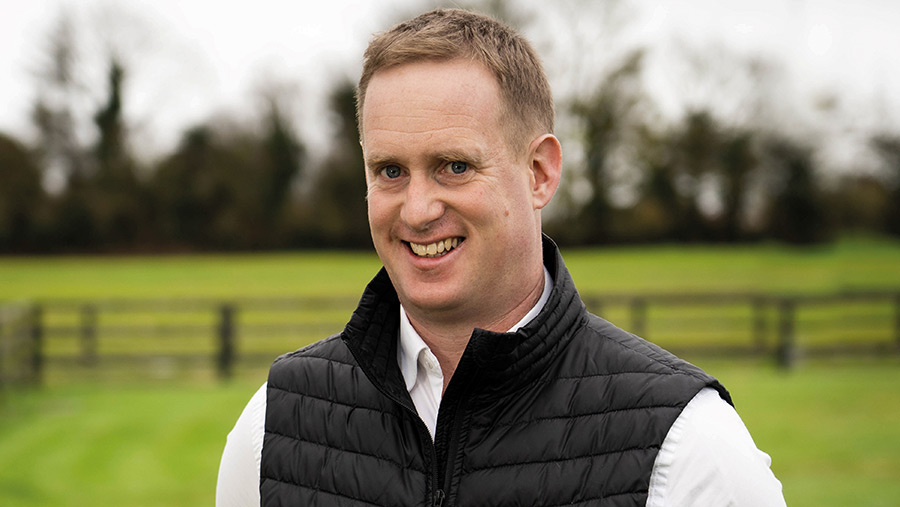How an Irish farmer combines grazing with milking robots

Brian O’Riordan © Caroline Keane
A system of milking robots with grazing is proving a labour-saving and productive combination for one Irish dairy producer.
Fourth-generation farmer Brian O’Riordan runs a 65-head dairy herd in Cork, Ireland. This is on a par with the average herd size in the country, of about 65-70 cows.
Both he and his wife have full-time jobs off the farm, so it is important for the setup to be as labour-efficient as possible.
See also: How a dairy farmer has integrated robots and grazing cows
For him, this efficiency is achieved predominantly from grazing.
Below, Mr O’Riordan talks through why grazing is a good option for robotic farmers and how it works on his farm.
Benefits of grazing
Dairy production systems in Ireland revolve mainly around grazing as grass is the most readily available feed source.
“[Grazing] is cheap compared with bought-in compounds, and we are able to produce excellent-quality grass to provide cows with high nutritional-value feed,” says Mr O’Riordan.
Extended grazing periods enable reliable milk-from-grass production for up to eight months of the year.
Farm facts
- 65 Friesian dairy cows
- 22ha (55-acre) grazing platform
- 230 days of grazing
- Yield – 6,300 litres a cow
- Butterfat – 4.26%
- Protein – 3.48%
- Milk solids a cow – 487kg
- Spring block-calving
- Six-week calving rate – 95%
“We see better cow welfare with a grass-based system, and do not tend to see any issues with rumination or gut health. That said, we do not have overly high-yielding cows, so it suits this system well,” he says.
What’s more, in Ireland it is nearly impossible to get a milk contract if you are not predominantly grazing your cows, he adds.
The business is paid on a constituent basis (see “Brian O’Riordan’s farm milk price breakdown”, below), which he says is likely to be different to that of a lot of UK producers.
This means the aim is to try to maximise kilos of milk, rather than litres.
“For me, grass also offers a big labour saving. I find when my cows are in over the winter, my workload increases significantly.”
How the robotic grazing system works
The grazing period averages 230 days a year, with turnout usually in March.
The farm operates an “ABC” grazing system (see “Robotic grazing at Brian O’Riordan’s farm”, below). This works by dividing the grazing platform into three blocks: A, B and C. They do not have to be equal sizes.
A Lely Grazeway automatically allocates cows to one of the three blocks, depending on the time of day.
The blocks are split as follows:
- A block (6pm-2am) – night-time block, closest to the farm, equating to 20% of the milking platform
- B block (2am-10.30am) – equating to 40% of the milking platform
- C block (10.30am-6pm) – also 40% of the milking platform and the furthest from the farm.
Robotic grazing at Brian O’Riordan’s farm

Source: Brian O’Riordan
Cows are free to come in and out of the grazing block whenever they like – it is only the block they go out to which may change if their movement coincides with one of the changeover times.
The blocks are designed to stimulate a desire to graze at all times of the day. The aim is to achieve an average time in any one block of six to eight hours a cow.
Under-allocating pasture will cause cows to move more quickly and may cause too many visits, explains Mr O’Riordan. On the other hand, over-allocation is likely to result in more labour, cows are likely to be slower to move and there is a risk of not hitting residuals.
Regular monitoring of grass growth is important. Dry matter (DM) targets are between 1,300-1,500kg DM/ha.
“I do not like feeding higher than this as it slows down the rotation,” he says. “If DM does go over this level, I take the paddock out of the rotation and cut it for bales.
“A key part of successful grazing is being reactive, and sometimes you may have to adapt the strategy if DM is not where you want it to be,” he adds.
Careful monitoring of the cows is also important. If conditions are particularly wet, a bale of straw may be put out with the herd, and if they are really bad, Mr O’Riordan will open up the cubicles to let the cows come in and lie down.
Because the farm is highly stocked – 3.1 cows a hectare – supplementary feeding may be needed at peak times of the year. While drought does not tend to be an issue, cows may be given an additional feed of high-DM silage in periods of excessive rain or at the shoulders of the year (spring and autumn).
Brian O’Riordan was speaking at a recent webinar hosted by ForFarmers.
Brian O’Riordan’s tips for setting up a robotic grazing system
- Free cow traffic is pivotal to the system – cows must be able to leave a paddock at any stage and visit the robot
- Roadways, grazeways and water trough positioning are very important, too – keep gate times consistent and strategically place water to encourage cows to leave paddocks
- A common myth is that the yard has to be in the centre of the grazing platform, but this is not necessary to a successful grazing system
- Always have the next rotation in mind: maintain the ground and ensure cows are grazing the paddock evenly. We aim for a rotation of 18-25 days
- Take into consideration your system and cow type before making any drastic changes. The ideal cow for us is about 650kg (mature weight) with the capacity to give 6,500 litres of milk
- Remember, an outdoor, grazed system will not work for everyone
